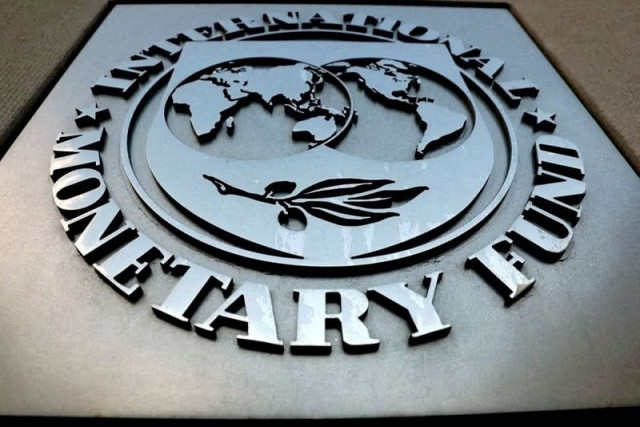PM gets first-hand knowledge of IMF-dictated budget
Outlay set at around Rs18tr, up 24% from this year's original budget

The finance ministry has presented a blueprint of the International Monetary Fund-dictated new budget to Prime Minister Shehbaz Sharif, proposing a nearly Rs18 trillion budget, which is one-fourth higher than this year's due to a record Rs9.7 trillion allocation for interest payments.
The budget numbers are still up in the air due to disagreements over the actual amount of interest payments, the Federal Board of Revenue’s (FBR) tax collection target, and the primary budget surplus target.
As part of the expenditure rationalisation efforts, the PM was also told that the government may also have to wind up eight to 10 federal ministries. A formal announcement is expected during Finance Minister Muhammad Aurangzeb’s budget speech, according to the sources.
The sources said that the prime minister has asked to further enhance the proposed Rs12.4 trillion for the FBR as tax collection target. The premier also sought a further increase in the proposed Rs1 trillion allocations for the Public Sector Development Programme (PSDP).
The finance ministry informed the premier that the size of the budget, the target of the primary budget surplus and the allocations for the interest payments were still tentative due to ongoing discussions with the IMF.
The IMF team has been in town since May 10 on a two-week mission to review and approve the budget before deciding on the new debt instrument for lending to Pakistan.
The sources said that based on the discussions with the IMF the size of the next year’s budget could be around Rs18 trillion –up by 24% over this year’s original budget.
The massive increase in the size does not reflect the harsh economic ground realities but the finance ministry's hands are tied due to the IMF’s insistence on the Rs9.7 trillion allocations for the interest payments.
The sources said that the IMF was not budging from its calculations of around Rs9.7 trillion allocations for the interest payments. It is 33% higher than this year’s original budget. The finance ministry has estimated Rs8.8 trillion to Rs9 trillion cost of the interest payments during the next fiscal year, they added.
The higher allocations would mean that the global lender does not see a major drop in the interest rates that stand at historically higher levels of 22% and suffocate the economic growth.
The ministry of defence has sought over Rs2.25 trillion for the defence spending but the sources said that the finance ministry has indicated close to Rs2.1 trillion. It will be around 16% higher than this fiscal year.
Read IMF aims to milk more taxes from salaried individuals
The dates for the budget presentation in the National Assembly remain tentative due to the prime minister’s visit to China from June 4 to 7.
The ministry has also indicated around Rs1 trillion for the PSDP spending, which is only 5% higher than this year’s original budget. The PM asked to further increase the allocations, as the proposed allocation was not sufficient to finance the ongoing development schemes.
The prime minister has already constituted a committee under Planning Minister Ahsan Iqbal to finalise the new development budget.
The pensions are estimated to consume about Rs960 billion –up by one-fifth over this year’s allocation. The government is in the process of reviewing the pension benefits but no final decision has yet been taken.
The Rs18 trillion budget would have a black hole of Rs9.6 trillion. The sources said that the federal budget deficit is projected to be around Rs9.6 trillion or 7.7% of the gross domestic product. This will be funded by taking more loans from the domestic banks and the foreign lenders.
The projected federal deficit is 28% higher than this year’s original estimates.
The sources said that the overall deficit target could be around 6.8% of the GDP or Rs8.5 trillion. The government expects the provinces to show a cash surplus of Rs1.1 trillion or 0.7% of the GDP.
Expecting this much cash surplus would require the government of Punjab to stop announcing new welfare schemes and the restraints to be shown by the Khyber Pakhtunkhwa government.
The sources said that the primary budget surplus target might be 1% of the GDP or Rs1.25 trillion. They said that the target was not final and would require further deliberations with the IMF once the FBR’s target is firmed up.
They said that another outstanding issue was the subsidies, which the IMF was asking to keep less than this year’s level.
The premier was told that the FBR’s tax collection target could be Rs12.4 trillion –one-third higher than this year’s original benchmark. They said that about Rs1.3 trillion in additional revenue measures must be required to achieve this target.
The automatic additional revenue collection without new taxes is estimated at around Rs1.6 trillion, which takes the FBR revenues to nearly Rs11 trillion but then would require massive new taxation to reach the new target.
The premier wanted to further raise the FBR target in order to reflect the ongoing reforms and enforcement efforts, said the source.



















COMMENTS
Comments are moderated and generally will be posted if they are on-topic and not abusive.
For more information, please see our Comments FAQ